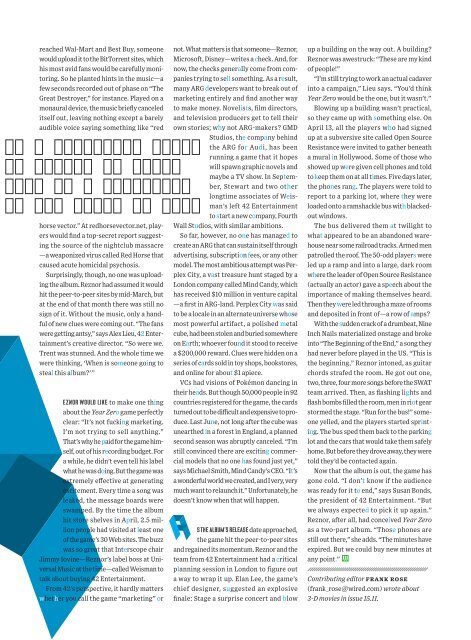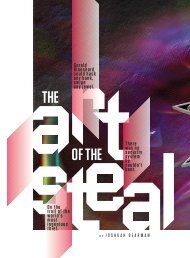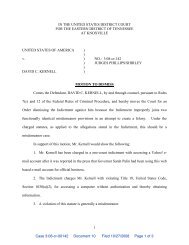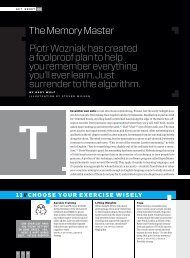Create successful ePaper yourself
Turn your PDF publications into a flip-book with our unique Google optimized e-Paper software.
eached Wal-Mart and Best Buy, someonewould upload it to the BitTorrent sites, whichhis most avid fans would be carefully monitoring.So he planted hints in the music—afew seconds recorded out of phase on “TheGreat Destroyer,” for instance. Played on amonaural device, the music briefly canceleditself out, leaving nothing except a barelyaudible voice saying something like “redhorse vector.” At redhorsevector.net, playerswould find a top-secret report suggestingthe source of the nightclub massacre—a weaponized virus called Red Horse thatcaused acute homicidal psychosis.Surprisingly, though, no one was uploadingthe album. Reznor had assumed it wouldhit the peer-to-peer sites by mid-March, butat the end of that month there was still nosign of it. Without the music, only a handfulof new clues were coming out. “The fanswere getting antsy,” says Alex Lieu, 42 Entertainment’screative director. “So were we.Trent was stunned. And the whole time wewere thinking, ‘When is someone going tosteal this album?’”eznor would like to make one thingabout the Year Zero game perfectlyclear: “It’s not fucking marketing.I’m not trying to sell anything.”That’s why he paid for the game himself,out of his recording budget. Fora while, he didn’t even tell his labelwhat he was doing. But the game wasextremely effective at generatingexcitement. Every time a song wasleaked, the message boards wereswamped. By the time the albumhit store shelves in April, 2.5 millionpeople had visited at least oneof the game’s 30 Web sites. The buzzwas so great that Interscope chairJimmy Iovine—Reznor’s label boss at UniversalMusic at the time—called Weisman totalk about buying 42 Entertainment.From 42’s perspective, it hardly matterswhether you call the game “marketing” ornot. What matters is that someone—Reznor,Microsoft, Disney—writes a check. And, fornow, the checks generally come from companiestrying to sell something. As a result,many ARG developers want to break out ofmarketing entirely and find another wayto make money. Novelists, film directors,and television producers get to tell theirown stories; why not ARG-makers? GMDStudios, the company behindthe ARG for Audi, has beenrunning a game that it hopeswill spawn graphic novels andmaybe a TV show. In September,Stewart and two otherlongtime associates of Weisman’sleft 42 Entertainmentto start a new company, FourthWall Studios, with similar ambitions.So far, however, no one has managed tocreate an ARG that can sustain itself throughadvertising, subscription fees, or any othermodel. The most ambitious attempt was PerplexCity, a vast treasure hunt staged by aLondon company called Mind Candy, whichhas received $10 million in venture capital—a first in ARG-land. Perplex City was saidto be a locale in an alternate universe whosemost powerful artifact, a polished metalcube, had been stolen and buried somewhereon Earth; whoever found it stood to receivea $200,000 reward. Clues were hidden on aseries of cards sold in toy shops, bookstores,and online for about $1 apiece.VCs had visions of Pokémon dancing intheir heads. But though 50,000 people in 92countries registered for the game, the cardsturned out to be difficult and expensive to produce.Last June, not long after the cube wasunearthed in a forest in England, a plannedsecond season was abruptly canceled. “I’mstill convinced there are exciting commercialmodels that no one has found just yet,”says Michael Smith, Mind Candy’s CEO. “It’sa wonderful world we created, and I very, verymuch want to relaunch it.” Unfortunately, hedoesn’t know when that will happen.s the album’s release date approached,the game hit the peer-to-peer sitesand regained its momentum. Reznor and theteam from 42 Entertainment had a criticalplanning session in London to figure outa way to wrap it up. Elan Lee, the game’schief designer, suggested an explosivefinale: Stage a surprise concert and blowup a building on the way out. A building?Reznor was awestruck: “These are my kindof people!”“I’m still trying to work an actual cadaverinto a campaign,” Lieu says. “You’d thinkYear Zero would be the one, but it wasn’t.”Blowing up a building wasn’t practical,so they came up with something else. OnApril 13, all the players who had signedup at a subversive site called Open SourceResistance were invited to gather beneatha mural in Holly wood. Some of those whoshowed up were given cell phones and toldto keep them on at all times. Five days later,the phones rang. The players were told toreport to a parking lot, where they wereloaded onto a ram shackle bus with blackedoutwindows.The bus delivered them at twilight towhat appeared to be an abandoned warehousenear some railroad tracks. Armed menpatrolled the roof. The 50-odd players wereled up a ramp and into a large, dark roomwhere the leader of Open Source Resistance(actually an actor) gave a speech about theimportance of making themselves heard.Then they were led through a maze of roomsand deposited in front of—a row of amps?With the sudden crack of a drumbeat, NineInch Nails materialized onstage and brokeinto “The Beginning of the End,” a song theyhad never before played in the US. “This isthe beginning,” Reznor intoned, as guitarchords strafed the room. He got out one,two, three, four more songs before the SWATteam arrived. Then, as flashing lights andflash bombs filled the room, men in riot gearstormed the stage. “Run for the bus!” someoneyelled, and the players started sprinting.The bus sped them back to the parkinglot and the cars that would take them safelyhome. But before they drove away, they weretold they’d be contacted again.Now that the album is out, the game hasgone cold. “I don’t know if the audiencewas ready for it to end,” says Susan Bonds,the president of 42 Entertainment. “Butwe always expected to pick it up again.”Reznor, after all, had conceived Year Zeroas a two-part album. “Those phones arestill out there,” she adds. “The minutes haveexpired. But we could buy new minutes atany point.” Contributing editor frank rose(frank_rose@wired.com) wrote about3-D movies in issue 15.11.
















